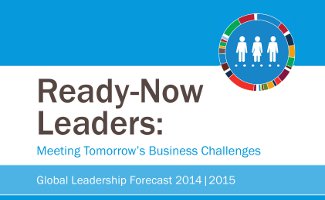Are We There Yet? Developing Ready-Now Leaders
26 Aug. 2014 | Comments (0)
![]()
In delivering research briefings around the world, I am always struck by how many of our issues remain the same, no matter what part of the world. Human Capital execs who attend speak of their challenges with talent shortages, acquisition of new talent with the right “cultural fit,” effective onboarding and development approaches to shorten the time to efficiency, compensation pressures, retention of key talent and raising engagement levels. Yet, the one issue that is the most frequent and the most daunting seems to be that of developing leaders…whether senior leaders or first time supervisors, high potentials or high professionals, women or minorities, Gen X or Millennials, in emerging markets and developed economies.
Despite the massive focus and the amount of time and resources devoted to it, a robust, effective cadre of leaders to drive the organization forward seems to be an elusive goal for most organizations. We’ve all been at this for a long time and made some strides. But the question remains, are we there yet? The short answer is no.
And it’s not going to get easier. We are overseeing the generational shift from Boomer-era leaders to Gen X leaders with Millennials nipping at their heels. Given how long Gen X has been waiting in the wings to finally go on stage, they are unlikely to want to accommodate the eager understudies who want their moment in the spotlight sooner rather than later. But as with all understudies, the challenge is to keep them eager, excited about the future opportunity and poised to take the place of the current lead in a role they (hopefully) will still want having waited so long to step into it. Some of these understudies (think eager Millennial) will decide it’s too long a wait (think anything more than a couple of years) and will step into a starring role (think Vice President or equivalent new-age title) at a smaller avant-guard performance space (think Silicon Valley start-up) to satisfy the urge to perform (think running the marketing department), even if it’s a smaller venue (think venture capital funding) and an unknown playwright (think guru sitting in a Starbucks with a compelling business idea sketched on the back of a flyer re: responsibly grown coffee beans).
 As challenging as this is, there are reasons why organizations need to get this right. A few thoughts on the challenge of preparing Millennial leaders in this edition of the Global Leadership Forecast report….
As challenging as this is, there are reasons why organizations need to get this right. A few thoughts on the challenge of preparing Millennial leaders in this edition of the Global Leadership Forecast report….
- Millennials are less engaged in their roles and are more likely to intend to leave in the next 12 months than leaders in other generational groups.
- Compared to those labeled Generation X, Millennials are less concerned with opportunities to provide feedback to their senior leaders about the organization’s strategy and culture, the organization’s communications about specific behaviors needed to succeed as a leader, and work-life balance.
- Contrary to many stereotypical beliefs, their preferences mirror those of other generations when using other methods for leadership development, such as formal workshops, training courses, online learning, and developmental assignments (e.g., special projects).
- Millennials also have a stronger preference for using social learning (e.g., social networks, wikis, and blogs) and mobile development (e.g., smartphones or tablets) for improving leadership skills than other generations, and they tend to learn from others more frequently. The engagement level of this group can be raised by providing them with a greater understanding of their career path as a leader and improving their manager’s effectiveness.
So what can be done? Try this…
- Reevaluate the employee value proposition, especially as it relates to the needs and aspirations of multiple generations.
- Offer flexible arrangements and a clear framework for career development that reinforces the opportunities that abound.
- Build virtual, social and mobile learning platforms and leadership development programs that provide opportunities to connect with others, both virtually and in person.
- Be creative about developing leaders outside the organization at social purpose organizations where these Millennials can gain experience and be of service.
There’s much more to the conversation on this topic and a range of others. I hope you will take a few minutes to read this report, Ready-Now Leaders: Meeting Tomorrow’s Business Challenges, the Global Leadership Forecast 2014-2015, our joint research project with Development Dimensions International (DDI).
View our complete listing of Leadership Development blogs.
-
About the Author:Rebecca L. Ray, PhD
The following is the bio of a former employee/consultant Rebecca L. Ray, Executive Vice President, Human Capital, is a member of the Executive Committee and led the US Human Capital Center for The Co…



0 Comment Comment Policy